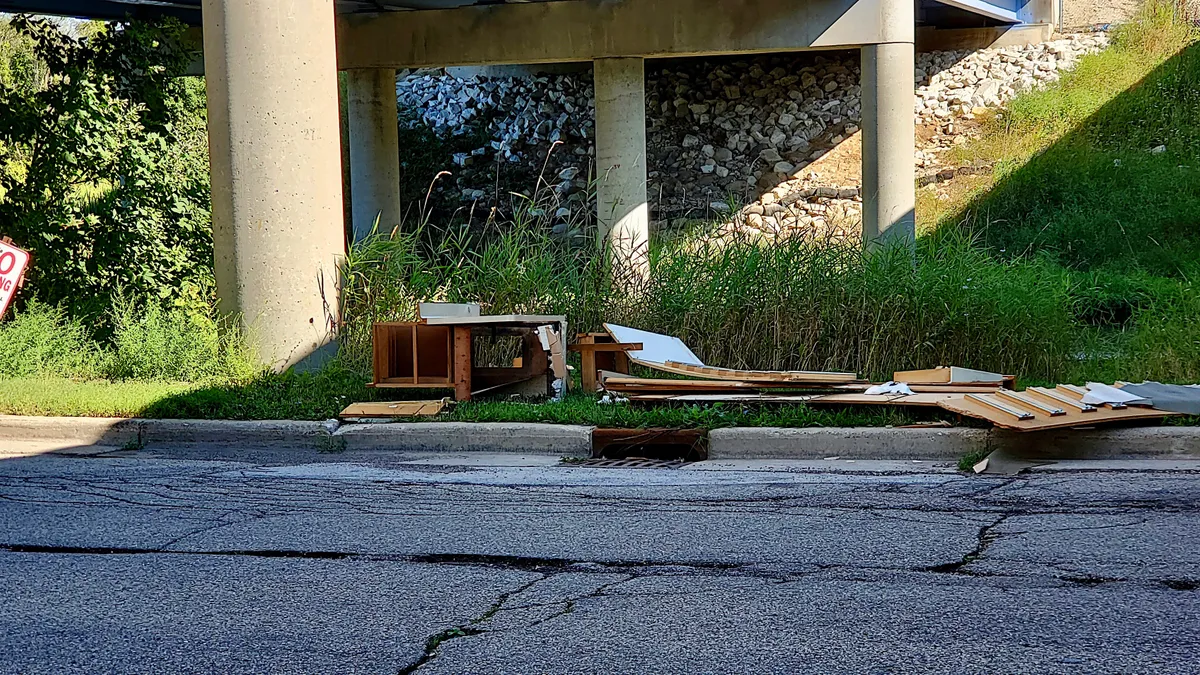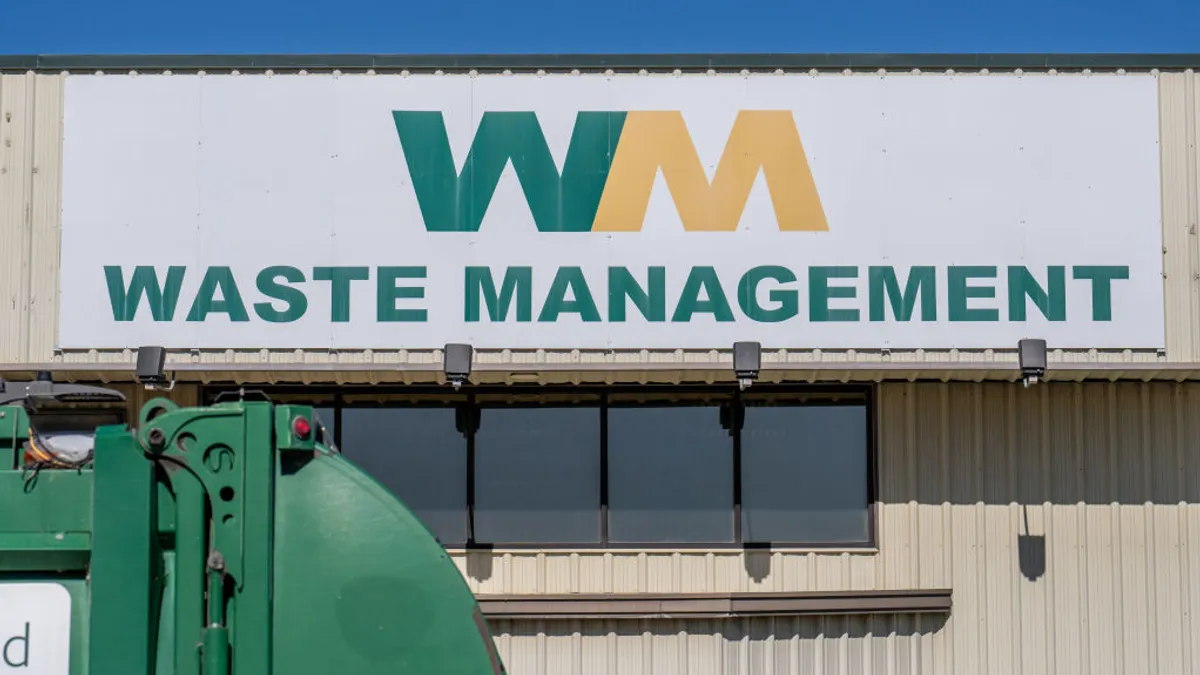Editor’s Note: Waste and recycling is an inherently local issue in the United States, and we’re looking for new ways to highlight how these stories fit into broader trends. Send us your tips or feedback at waste.dive.editors@industrydive.com.
Illegal dumping vexes cities
Throughout the pandemic, officials and news reports across the country have revealed case after case of illegal dumping problems. While culprit items often include auto parts, furniture or construction materials, recent examples include inappropriately ditching speared fish and even a headstone.
Los Angeles Controller Ron Galperin recently issued a report highlighting that illegal dumping of trash, debris and hazardous items in the city’s public areas spiked 450% between 2016 and 2020. Galperin called the problem one “of equity as much as it is of health and safety.”
LA, which the sanitation department said is a participant in the CalRecycle Illegal Dumping Technical Advisory Committee, is set to weigh recommendations from the controller’s office meant to target root causes of the problem and better enforce the law. They include increasing the number of cleanup crews, expanding the surveillance camera program, and raising fines for offenders. Also on the list are heightening oversight of commercial trash customers and construction projects and creating a public awareness campaign to spotlight free and low-cost trash disposal services. The city council has not yet reviewed or made decisions on the recommendations, a controller’s office spokesperson said.
Opinions vary on the key factors perpetuating the problem throughout the U.S. Columbia, Missouri, officials say the city has seen an uptick in illegal dumping since implementing a pay-as-you-throw trash bag policy in February. Enforcement is another issue; in Milwaukee, Wisconsin, an investigation by news station TMJ4 showed the city’s Department of Neighborhood Services received nearly 55% more complaints of illegal dumping during 2020 than in the prior year, but only issued 14% more citations.
Of all the possible solutions, increasing use of technology — particularly surveillance cameras to catch offenders — may be a popular choice. The LA report, which calls for more cameras, notes there are just 19 cameras in an area with 6,500 miles of roadway. By comparison, Philadelphia has 100 cameras covering 2,200 miles of roadway and Phoenix has 26 cameras across 4,900 miles of roadway.
Aside from illegal dumping, cameras are also being used to more proactively address litter in general – another pandemic issue. During a webinar this week hosted by “crowdsource cleaning” technology company Litterati, waste and cleanup leaders from Wake County, North Carolina, and Memphis, Tennessee, discussed their local efforts helped by the platform, which enables residents or municipal governments to collect data and identify patterns in locations and types of trash. In the case of Wake County, one initial reason for trying out the new tech was that leaders weren’t necessarily seeing the amount of traction they wanted from previous campaigns, and county demographics were changing.
“We began to question whether our reliance on paid advertising was really bringing us the results we wanted,” said Bianca Howard, marketing and outreach supervisor at Wake County Solid Waste Management.
Increasing human-power to help with broader clean-up needs is another choice, particularly as cities look to transition out of the pandemic and may have access to new federal funding. New York City this week announced a City Cleanup Corps, which it describes as “a New Deal-inspired economic recovery program” that will hire 1,000 people this month and build up to 10,000 jobs to revitalize and beautify public spaces and neighborhoods.
Recycling recap: Curbside pricing and collection programs
After a turbulent few years, there’s some optimism about the overall economic future of curbside recycling.
Public companies have reported commodity value upticks for multiple quarters in 2020. The ever-growing rise in e-commerce activity is boosting prices for OCC and resulting cardboard boxes. Speakers at the recent Plastics Recycling Conference and the Northeast Recycling Council’s spring conference said they expect brand pledges to use more post-consumer recycled plastics will continue to drive demand. One IHS Markit speaker even foresees recycled polypropylene eventually becoming somewhat cost-competitive with virgin material, to the point more MRFs may feel it’s worthwhile to “take the time and effort to get it out of their streams and separated and into downstream markets.”
But amid these macro trends, other headlines make it clear that the recycling resurgence narrative remains a complex and highly local one around the country.
In Memphis, Tennessee, residential material will get recycled for the first time in five months following a pandemic-related disruption. Louisiana’s Loyola University New Orleans will also resume recycling service after more than a year without, following a change in contractors.
In a still rare occurrence, various types of plastic film recycling will now be available to more residents. Palmer Township, Pennsylvania, signed on with J.P. Mascaro’s flexible packaging collection program. Matawan, New Jersey, is partnering with SC Johnson for a year-long pilot collecting similar material via a separate bin. A local source indicates the move by some area communities to start collecting film has sparked some debate, given a pending statewide law limiting plastic bags and a recent period of high recycling costs due to the lack of a local MRF. Meanwhile, Madison, Wisconsin, will no longer accept plastic film curbside because processor Pellitteri Waste Systems has no market for it.
Elsewhere in the U.S. the costs and types of recycling are also shifting. Flagler Beach, Florida, recently told residents to only recycle aluminum and corrugated cardboard due to cost issues. Free drop-off recycling is coming to an end in Chaffee County, Colorado, following the decision by a local contractor. Multiple local governments in Pennsylvania are also in the process of raising rates for service, with some looking at ways to drop glass or collect it separately and the city of Wilkes-Barre prepping for a shift to dual-stream.
More updates from around the country:
- The pandemic isn’t over yet, but New York Gov. Andrew Cuomo is looking at how to memorialize it. Sanitation workers were recently highlighted among 17 key groups to be honored in an Essential Workers Monument, with the Teamsters union representing New York City sanitation workers on an advisory committee to sort out the details.
- Chicago’s Department of Streets and Sanitation will continue collection service in two of six city zones and hand the rest to LRS via a three-year contract. The $79.6 million deal marks a key expansion for the local company, and the end of Waste Management’s residential collection contract. (Waste Dive)
- Washington, DC’s Zero Waste Omnibus Amendment Act recently became law – with provisions around organics diversion, battery recycling and lots more – but implementation funding remains uncertain. (Waste Dive)
- Memphis appears to be moving toward Waste Pro’s desired outcome of ending a contentious local collection contract, following ongoing service delays, with Mayor Jim Strickland saying the company has “completely failed us.” Team Waste has been contracted on a temporary basis to help catch up. (FOX13)
- Recycling in Tulsa, Oklahoma, is temporarily going to a local Covanta facility after fire damage at a city transfer site. A lithium-ion battery was the culprit. (Public Radio Tulsa)
- Three years into a disposal ban, Lincoln, Nebraska, has seen cardboard recycling volumes hit record highs. Anticipated revenue hasn’t followed yet, due to market factors, but officials say they’re pleased with the progress and preservation of landfill capacity. (KOLN)
- Voters in Fort Collins, Colorado, recently approved a ban on single-use plastic and bags and fee on paper bags – the 16th community to have such a policy in the state – as lawmakers continue debating statewide policies around this issue. (Coloradoan)
Surplus of stuff
Whether it’s illegal dumping and litter trends, or heightened volumes due to home cleanout activity, the pandemic continues to have ripple effects on how stuff is handled around the country.
While many curbside bins and donation sites have been inundated (a Maine Goodwill network saw 13.2 million pounds of “bad donations” last year) people are also finding other ways to keep their unwanted items in circulation.
In New York, a longstanding tradition is receiving new attention through the popular Stooping NYC Instagram account, whose co-founder recently told WNYC their aim is to support a “full circle stooping community” that supports leaving items outside for free. In Somerville, Massachusetts, “little free libraries” have reportedly taken on new meaning during the pandemic with some people driving from outside towns to browse certain locations given limited in-person access to some bookstores and libraries. And, as recently profiled nationally, Facebook and Craigslist remain vibrant hubs for selling or gifting a wide range of eclectic items.
What’s been happening with donation and reuse in your community during the pandemic? Are you seeing any interesting examples of support or facilitation by municipalities? Get in touch at waste.dive.editors@industrydive.com.
Additional reporting by Megan Quin



















